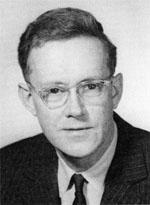
Edward Mills Purcell and Nuclear Magnetic Resonance (NMR)Resources with Additional Information Edward M. Purcell was awarded the 1952 Nobel Prize in Physics for his "development of new methods for nuclear magnetic precision measurements and discoveries in connection therewith". Purcell first observed nuclear magnetic resonance (NMR) in 1945 while working at the Massachusetts Institute of Technology (MIT) Radiation Laboratory in an after-hours experiment.  Courtesy Engineering Computer Network Purdue University ‘Though initially used in physics, NMR has been applied powerfully as an analytic method for elucidating chemical structure and materials properties. The Nobel prize winning discovery is also the basis of medical resonance imaging (or MRI), now routinely used as an elegant and non-invasive diagnostic tool, producing beautifully detailed images of the body's interior... Purcell's other contributions ... included a comprehensive theory of nuclear magnetic relaxation (with [Nicolaas] Bloembergen and [Robert V.] Pound - the famous "BPP" paper, one of the most cited references in physics); the concept of negative spin temperatures (with Pound), which was a precursor to the maser and laser; improved spin-echo techniques (with [H. Y.] Carr); and explanations of the absorption and scattering of starlight by interstellar grains. With [Norman F.] Ramsey he was the first to question the conventional assumption (later disproved) that all particle forces are parity symmetric. With Berg he applied physics to biological problems, in their description of the physics of chemoreception and in his classic paper (in The American Journal of Physics) "Life at Low Reynolds Number," a life whose locomotion is dominated by viscosity. In that same journal his monthly "Back of the Envelope" problems challenged and delighted a large audience of physicists. Purcell's stunning introductory textbook on Electricity and Magnetism has educated and inspired a generation of physicists, who refer to it often, and depend on it utterly.1 Purcell "was a past president of the American Physical Society and a member of the National Academy of Sciences, American Philosophical Society and American Academy of Arts and Sciences. In 1967, he won the Oersted Medal of the American Association of Physics Teachers, and in 1979, he received the National Medal of Science. Purcell served as a science advisor to Presidents Eisenhower, Kennedy, and Johnson."2 1Edited excerpts from Faculty
of Arts and Sciences Memorial Minute – Edward Mills Purcell
2Excerpt from Doctor of Engineering Honorary Degree Recipient
Resources with Additional InformationAdditional information about Edward Purcell and his work is available in full text and on the Web. Documents:
A Precise Determination of the Proton Magnetic Moment in Bohr Magnetons;
Physical Review, Vol. 76, Issue 8: 1262-1263; October 15, 1949
On the Possibility of Electric Dipole Moments for Elementary Particles and Nuclei; Physical Review, Vol. 78, Issue 6: 807; June 15, 1950 Interaction between Nuclear Spins in HD Gas; Physical Review, Vol. 88, Issue 2: 415-416, October 15, 1952 Nuclear Magnetic Resonance in Solid Hydrogen; Physical Review, Vol. 91, Issue 3: 631-641, August 1, 1953 Effects of Diffusion on Free Precession in Nuclear Magnetic Resonance Experiments; Physical Review, Vol. 94, Issue 3: 630-638, May 1, 1954
Search for the Dirac Monopole with 30-BeV Protons; DOE
Technical Report;
Physical
Review, Vol 129, Issue 5: 2326-2336, March 1, 1963
Additional Web Pages:E. M. Purcell – Biographical Memoirs Edward Purcell Interview (June 14, 1991) A Life-Saving Window on the Mind and Body: The Development of Magnetic Resonance Imaging Shed No Tears – Story about the shed where Purcell first observed nuclear magnetic resonance (NMR) |


 |
Information
Bridge • Energy
Citations Database • E-print
Network • R&D
Accomplishments
About OSTI Science.gov • USA.gov • USAJOBS • Grants • Regulations.gov |
|---|